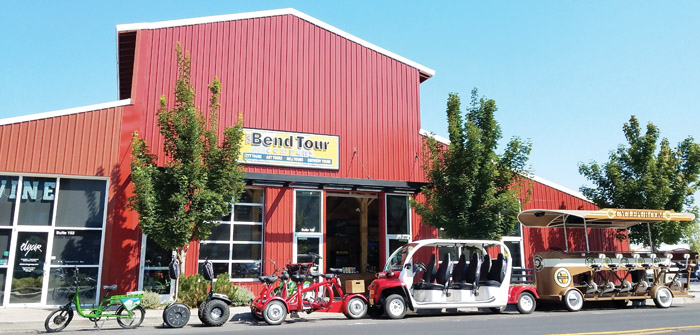(Photo above | Box Factory | Photo by John Flannery, Bend Tour Company)
Supply Challenges Across Sectors Demanding Creative Solutions
Real Estate in Central Oregon has been a hot topic throughout the market’s various cycles — some seeing more seismic shifts than others — of recent history, but has moved into a more nuanced conversation as the region continues a record pace of population growth, with demand outstripping supply across the board.
The recurrent theme in the residential realm is that relatively low inventory levels in the face of ongoing strong buyer interest is continuing to push the price point envelope, exacerbated by rising land, development and skilled labor costs.
Increasing median home values in Bend have also had a spin-off effect of pushing demand into other areas of the region, with Redmond in particular benefiting.
And with more diverse housing options being sought, an increasing number of apartment projects — the biggest wave since 1980 in Central Oregon — are also coming online; reflective of increasing urbanization.
It is somewhat of a similar story on the commercial front, as supply constraints translate into solidifying rental rates, with multiple indicators pointing to another strong year both nationally and locally, continuing the trend of one of the longest periods of economic expansion in U.S. history.
Bend residential real estate market statistics, compiled from MLS data by specialist brokers Cheri Smith & Molly Brundage of Total Property Resources show there were 425 single-family homes for sale, 342 pending sales, and 506 homes had sold through the first quarter of 2018, up 15 percent from this time last year.
The majority of home sales occurred in the $350,000-$399,999 price range with 92 closed transactions, followed by the $300,000-$349,999 price range with 86 closed transactions. The $400,000-$449,999 price range was a close third with 74 home sales. At the time these statistics were compiled, there was not a single home listed for sale in Bend under $250,000, and only six homes for sale in the $250,000-$299,999 price range.
Compared to the same period last year, the average sales price increased 10.42 percent to $484,539 and the median sales price increased 10.14 percent to $414,663, with home values within the Bend city limits varying significantly, particularly from the west to east side. The median sales prices for the four quadrants were $595,000 for NW, $507,500 for SW, $367,450 for SE Bend, and $355,500 for NE.
By the end of March there were 167 new homes for sale, making up 38 percent of all active listings. Of the 506 homes that sold in that period, 154 were new homes, accounting for 30 percent of all home sales.
There were 129 pending home sales in the new construction segment of the market, which is 38 percent of all pending sales. The average sales price for new construction was $487,006 and the median sales price was $400,360.
Brundage said, “Typically properties recently have been on the market for just over 100 days, and we are seeing transactions close on average at 98 percent of asking price.
“We have been running at around two-and-a-half months of inventory in Bend and 30 percent of that figure is new construction and we continue to have the challenge of a relatively shallow pool of inventory.”
Smith added, “I think that we are poised to have another three or four really good years in the residential market.
“Values continue to rise, although interest rates are expected to go up, which may particularly affect the entry level market. But many buyers from outside the area seem undeterred by the likelihood of somewhat modest rate hikes.
“Moves like more relaxed rules for additional dwelling units (ADU’s) would seem a step in the right direction to deliver more options on the housing front, but we are not seeing any typical slowdown trends and people continue to be attracted to move here from other areas, pushing demand while many builders are at capacity and having challenges finding subcontractors.”
On the commercial side, data compiled by Compass Commercial Real Estate Services for its regular Points newsletter illustrated office rental rates remaining strong in light of relatively short supply.
This mirrors national trends as the economy continues its slow but steady growth, but with land prices reaching all-time highs locally, new projects were anticipated to be difficult for developers to make pencil.
Coupled with rising construction and labor costs, this was likely to continue to squeeze the office market’s supply. While flagship projects like the Crane Shed Commons and the renovated Deschutes Ridge Business Park will continue to attract new and expanding users, smaller spaces that come on the market are expected to be quickly occupied.
On the retail front, despite the regular announcements of big box and other store closings in the U.S., particularly in light of escalating online competition, Central Oregon’s market has continued its strong growth.
Regarding recent activity, a Compass spokesman added, “The Robal Road Village shopping center and Box Factory spaces in Bend are filling up quickly, the former Erickson’s site has backfilled with a Planet Fitness chain, and preliminary plans for the former west side Ray’s Food Place include up to 20,000 sq. ft. of retail and over 200 apartments on five stories above.”
Meanwhile, the industrial sector has seen record rent levels and a low supply that “will continue to offer landlords excellent values on their properties” and potentially see more dispositions to maximize equity value through this year.
Brian Fratzke, owner of Fratzke Commercial Real Estate Advisors, observed, “Lack of industrial space for lease (less than 35,000 rentable square feet in the entire City of Bend), and lack of new development for all the companies trying to move to Central Oregon is a definite factor.
“Economic Development for Central Oregon (EDCO) and others are doing a great job of attracting businesses but there is no place for them to operate their companies. The rub is that it takes 24 months to build a facility and most of these firms need a place now!”
Again, demand may be seen pushed to outlying areas that may have larger industrial tracts with infrastructure available, while a perceived lack of affordable housing was having an impact on companies both trying to relocate or “grow in place”
In an effort to catalyze more diverse construction within Bend’s city limits, as part of the Urban Growth Boundary expansion process, areas inside the UGB (prior to the recently expanded boundary) have also been targeted for more intensive development and redevelopment to accommodate projected growth (see accompanying graphic indicating “Opportunity Areas”).
The City is currently working through how best to foster such development in these Opportunity Areas through potential policy changes, including considering tax incentives and ways to mitigate or finance Systems Development Charges (SDC’s) impact fees.
Generally, per capita income growth in Oregon has topped the US pace since 2015, with the economic strength principally driven by jobs, population and wage increases, which has been a driver of higher construction costs.
The relative scarcity of skilled labor has been a particular challenge for builders locally, with many in that subcontracting field having moved on to different industries following the previous downturn, or moved out of the area and did not return.
The rising interest rate environment will also likely have an impact on any speculative projects, with many being put on hold until they become economically feasible, and companies paying a premium for a building that meets their needs.
Adding to the commercial perspective, Lyons said, “Our research indicates vacancy rates continue to be historically low, at under four percent in the office sector and less than three percent for retail, and if you signed a lease five years ago you are likely facing quite an adjustment.
“There is a narrowing range of options for prospective tenants given the limited supply and on the investment side, buyers need to be ready to move quickly
given the high demand as a lot of capital chases relatively few deals.
“Central Oregon, and Bend in particular continues to be attractive and lease rates and values are anticipated to keep rising.”
As we delve into the current Central Oregon real estate perspective in this issue of Cascade Business News, it has become clear that a continued collaborative effort between the development community, City jurisdictions and other stakeholders is vital to tackle the myriad issues faced by the region.





